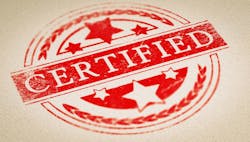Certification programs have grown substantially in recent years, mostly due to the growth and expansion in the general population. In the past, word of mouth in a location or region would validate an individual’s skills and expertise but this is insufficient in today’s global economy. Because professionals are scattered across the country and the globe, it takes a more strategic approach to validate skills. Certifications are one way to do that as they help prove an individual’s credibility to the market.
The U.S. Department of Labor sponsors the Career One Stop website, which helps users search for training and certifications in most any field of interest. A cursory search for certifications in "security industry knowledge" returns over 88 certifications from 39 different organizations. These are industry certifications, not typically manufacturer or product certifications.
Many manufacturers in the industry today offer a certification program; however, each program offers different benefits, has unique milestones and wildly varying quality standards. So the question must be posed – does certification make a difference? The answer is usually "yes," but with some notable caveats.
Alex Asnovich, director of marketing and learning & development at Hikvision, says their certification program is part of the company’s overall commitment to developing industry partnerships.
"We seek to provide certification programs that are cost-effective and convenient for our partners," he says. "Hikvision certification verifies the expertise of those who have completed the courses, and it gives assurance to end-user customers that they’re deploying the products and solutions that will help them achieve their security and business goals."
According to Ron Voroninkaitis, national manager - field efficiencies & technical training at Chubb Edwards, the real value from any one manufacturer certification program is keeping product knowledge up to date.
"Most vendor programs are designed to assist with troubleshooting and support as well. The manufacturers want to support people on a product for which they at least have some base knowledge," Voroninkaitis adds. "Certifications set a standard for the installation of the product – the workmanship required by the technician or installer."
While certification programs fall under the training umbrella, there are some relatively distinct differences between certification programs and typical training programs. Certification programs generally include an assessment of knowledge, skills and competencies. While training programs may include this type of evaluation, it is certainly not a requirement. Further, certification programs culminate in the bestowment of a credential which signifies that the holder has met a defined standard in terms of possession of, and ability to demonstrate, competencies. Training programs do not typically include this type of signifier. Some certification programs do not require training at all, providing individuals with the option to forgo training and skip straight to the assessment in order to achieve certification.
A Certification Program is a Real Investment
To be successful, certification programs require the direct support of upper management. Developing a certification program requires time, money and a lot of patience. Even still, initial development times are dwarfed by editing and launching requirements, even before accounting for marketing. Without a robust marketing engine that includes incentive for certification, you are setting yourself up for failure.
It is possible to spend anywhere from $250,000 to several million dollars over a two- to three-year period when developing a certification program. When accounting for the launch and marketing of the program, typical costs trend toward the higher end of this range.
Additionally, each organization must examine the question of build versus buy – should they commit to developing the certification program internally or outsource to a neutral third party? Remember that innovative approaches to a product certification program will help set you apart from the rest. With that said, there are a few key factors to consider when looking at the build versus buy equation:
- Resources spent for development detract from resources for implementation. Not many companies can focus simultaneously on development and implementation. One always wins out. Every dollar spent on development usually takes away funds from implementation. Additionally, development times and costs tend to exceed expectations.
- Quick wins pay off. All of the literature on effective organizational change emphasizes the need for quick wins. Getting programs from external suppliers enables you to act immediately. No matter how good an internal development team is, a high-quality certification program usually takes at least a year to develop, test and deploy. If a program or learning process you can implement this week stands to make a major impact on the performance of the organization, what's the cost of waiting 12 to 18 months? Probably high.
- Increase your batting average. Mounting evidence from hospitals shows that the more often procedures such as bypasses and hip replacements are done, the more successful they are. Simply put, experience produces better results. Fewer people die from procedures performed in experienced hospitals. Similarly, you're better off working with a training process or program that has been tested in a variety of challenging circumstances. Plus, external suppliers are in a position to consult on implementation issues; they can guide you around the pitfalls.
- Affect organizational culture. Sometimes, corporate training groups confuse themselves with a university by producing huge course catalogs which then yield minimal participation. Assume that a company with 1,000 employees offers 100 courses and an average of 20 people attend each. Some might argue that’s an impressive 2,000 training days, but a different scenario would have five high quality programs addressing basic issues. Assume that 400 people participated in each one of those five programs. That’s exactly the same number of training days, but imagine the impact on the culture if 400 people with the same function learned to use the same new skills and behavior. That’s cultural impact. It doesn’t require huge development staffs; it requires delivery capability and investment.
- Core competency focus. What is your core competency as an organization? Is it selling or manufacturing a product – or is it developing educational programs? My experience has been that if you (as an organization) could not sell training as one of your primary product lines which generate revenue, then it is not your core competency as an organization. If that is the case, it is best to leave the development of these programs to experts who do.
- Customize. Programs from suppliers can be tailored to the organization. A lot of tailoring occurs when skilled trainers adapt programs to fit their audience. Often, that's all that's needed. Beyond that, it's economical to modify programs that consist of front-ends, including a senior executive introducing the program, company-specific examples in written materials, nomenclature that conforms to the organization's lexicon, and workbooks or online branding displaying the company logo.
Steps to Developing the Certification
Whether building internally or working with a third-party vendor, the same basic steps go into the development of a quality certification program. First, complete a due diligence process and define a program’s objectives. Who is your target audience? What pain within the organization is this program trying to fix? Do you plan on launching locally, regionally or pushing for a more global engagement? These are just some of the questions to be addressed in the due diligence process. This is also the time when you will define the need and ability to support a certification program. It is important to keep in mind that a certification program is not always the right response to a training need or pain.
After you’ve done your due diligence and determined that a certification program is in order for your organization, you’ll need to:
1). Select a product. Your next steps in creating a certification program are determining what product or service you will design your certification around. It would be unwise to try and build a certification program covering all the products in your catalog. It may make more sense to select one or two products as part of a new product introduction, while defining alternate ways to support and share knowledge on legacy products.
2). Determining product features. This may seem obvious, but it is an important part of the certification program development process. Product features are simply "what" and "how" a product operates. Product benefits are the "why" or "when." In other words, a more technical certification will focus solely on product features, while a program geared for the sales group will also include the product benefits.
3). Develop a curriculum. Keep in mind that even the best trainers do not always make good instructional designers. Training is more of an art whereas instructional design is a science. Designers must have expertise in adult learning theory and are often certified themselves. Curriculum development involves defining the learning objectives, creating content storyboards, sifting through a wealth of information to define content in just the right way, and creating student takeaways. This is also one of the greatest hidden costs when creating a certification program. Experience tells us every one hour of training curriculum results from 40 hours of design and development work.
Hikvision elected to develop their certification program in tracks – one for sales and one for the technical audience. "These tracks are designed to offer a realistic application of Hikvision’s products, and prepare field-ready experts who understand the features and benefits of our product lines and how they can best be used inside a profitable margin and budget," Ansovich explains. "We offer a credentialing system upon completion of courses."
Along with developing curriculum is the process of selecting delivery vehicles. Will your certification be offered online or only in a classroom environment? Will there be a blended approach, such as offering online pre-testing, then in-class training, and an online final exam?
4). The process then takes an even more difficult turn with creating a test bank of questions to support the curriculum. It is essential that no test question be asked that is not taught in the course content and likewise no course content is included that does not tie directly to a learning objective. Understanding the finer points of writing quality test questions (such as avoiding true/false questions and rarely using "all of the above" as potential answer) is perhaps better left up to the experts such as psychometricians.
5). Next you are ready to test all of the material and test questions for validity and reliability. Working with a strong bank of beta testers will help facilitate this process. It is impossible to truly perform quality control on your own work, so it is also impossible to develop a certification program in a vacuum.
6). Finally, you are ready for program launch and implementation. Timing is everything when it comes to implementing your program. Data tells us that it is best to launch a certification program within 10 to 14 days of a product launch. Therefore, pre-planning for the certification program is mission critical.
7). The last and arguably most important step in certification creation is program maintenance. A program is only as effective as its regular maintenance. In the security industry, technology changes fast as do product features and software builds. It is essential that your certification program keep pace with industry and product changes by releasing regular updates.


